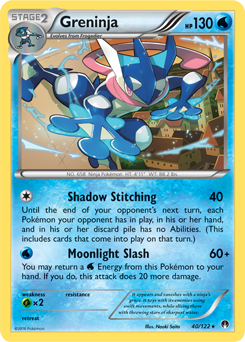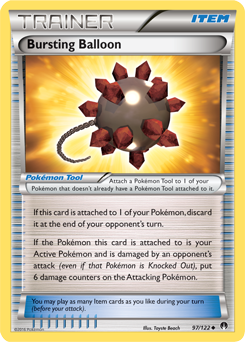The Moonlight at Night — Standard Greninja and Yveltal / Garbodor
What’s up PokeBeach? When I last wrote, we were on the verge of a brand new season, and now the dust has settled, revealing which decks will be the biggest contenders in the new format. Today I want to talk about Standard because it’s the format I have been testing the most.
Standard gets a lot of hate for its simplicity and limited card pool compared to Expanded, however, at the moment I still feel as though it is very diverse and offers an interesting experience the likes of which the game hasn’t really seen before.
The main decks in Standard at the moment are Greninja, Darkrai-EX / Giratina-EX / Garbodor, Rainbow Road, M Mewtwo-EX / Garbodor, Volcanion-EX, and Yveltal / Garbodor. Each of these decks interacts with the others in completely different ways, forcing you to have a strategy in mind for every matchup you could face. This makes deck building and metagame prediction incredibly important because the more accurate your guesswork is, the better equipped you will be for your tournaments.

Without any further introduction, I want to get to analyzing two decks which I consider to be the strongest plays for Standard at the moment. Both have their strengths and weaknesses just like the rest of the decks in the format, however after extensive testing I feel as though these two are the ones that have the most potential, depending on the kind of meta you are expecting.
Greninja
Greninja was incredibly underrepresented at Orlando largely due to the abundance of Garbodor decks. As a result, many have dismissed it as being a viable option for Standard anymore. However, I believe that with the right amount of preparation you could take this deck to a tournament and be ready to take on any Garbodor variant and expect a positive win rate.
The aim of the deck is to get a turn two Water Duplicates to fill your board with Frogadier, and then follow up by evolving into Greninja and Greninja BREAK in order to hit big damage for little Energy. Its strong points are the fact that all its attackers are high HP non-EX Pokemon that trade Prizes well with most other decks in the format.
The problem this deck has universally though is that it can be incredibly inconsistent sometimes when setting up. This means that you will inevitably have games where you will lose through no fault of your own. This is another reason why people tend to be reluctant to pick this deck up.
When the deck works though it is incredibly powerful due to how well it can trade Prizes with Pokemon-EX heavy decks. When you’re able to use Giant Water Shuriken all hell is bound to break loose and you usually end up snowballing the opponent towards the end of the game. Another one of its strengths is its ability to come back from behind by utilizing Supporters such as N and Ace Trainer, as well as trading favorably with Pokemon-EX.
The List
Potential Variations
-4 Talonflame, +1 Froakie, + 1 Jirachi, +2 Trainers’ Mail
Talonflame is an excellent card in theory, but in practice, it is sometimes a lot less effective. I like it at the moment, but I have had games where it has been useless, and of course if you don’t start with it then you will have four dead cards sitting in your deck. One of the best aspects of this card is that it increases your “Basic” Pokemon count which means you will mulligan less and also be in less danger of getting donked (where you fail to find another Pokemon to bench and your opponent Knocks Out your Active). Because of this, I would recommend replacing the Talonflame with at least two Basic Pokemon if you choose to take them out.
A fourth Froakie is an easy replacement and since you can’t add a fifth I’d recommend adding a single Promo Jirachi. Jirachi can be effective against Yveltal and Giratina-EX / Garbodor variants because those decks rely on their Special Energy a lot in this matchup. You can also use it as a buffer if you start with it to protect your Benched Froakie.
As for the other two spots, I’d add in two copies of Trainers' Mail. This will make it easier for you to find your outs to Froakie on turn one and therefore make it more likely for you to get multiple Froakie on the Bench.
-2 Rough Seas, +2 Faded Town

I find the M Mewtwo-EX matchup to be fairly positive, however if you feel as though you’re struggling against it I would recommend adding in a few Faded Town. If you play them down at the right times you should find that the additional damage swings the matchup a lot in your favour, but make sure you aren’t just playing them down randomly because then your opponent will simply counter your Stadium.
Pokemon
Nothing out of the ordinary here. The four Talonflame work great as a bulky free Retreat Pokemon that can sometimes help you get out of dead hands. If you go second its attack is insane, allowing you to grab everything you might need to ensure you get a turn two Water Duplicates. In the games where you don’t use its attack it usually just acts as a wall on the first turn that sometimes soaks up a little damage, and then remains on your Bench as a low threat free retreating Pokemon for the rest of the game.
The Greninja line is pretty solid. You want to be able to get out as many attackers as possible so the 4-4 line in the middle is essential. You only run two Greninja BREAK on the grounds that there will be very few games where you get more than two out, so there is little need to run more copies of the card. When running Talonflame it’s better to run just three Froakie because you won’t need any more Basic Pokemon, and a fourth would end up being a dead card most of the time as you just use Water Duplicates to get Frogadier out directly.
Supporters
You want as much draw as possible with this deck to help its consistency issues, so the 4 / 4 Professor Sycamore and N is crucial to the deck’s performance. Professor Sycamore is a solid draw Supporter that rarely causes you much harm when you discard cards thanks to Super Rod. N is also a great draw Supporter for you because you will often be behind until the end of the game. This is also why I choose to run two Ace Trainer, setting your opponent to three cards early on can set them really far behind. A lot of the time your opponent will take a Prize from Knocking Out a Froakie on their first attacking turn and then a Frogadier on their next. This means you could be setting them to a three card hand as early as turn two.
I only run Lysandre because I find it isn’t as useful in this deck as it is in a lot of others. Greninja BREAK allows you to snipe the Bench, and generally you want to be attacking the defending Pokemon anyways because it is usually their biggest threat. The Lysandre is there for when you need to target a threat on their Bench or take a cheap KO on something that you damaged earlier on.
I also run one Delinquent because the deck struggles a lot against Stadiums such as Parallel City and Shrine of Memories. It’s important in this deck to be ahead in the Stadium war and having a utility Supporter to help that can make a big difference. It is also good for discarding cards when your opponent has a small hand and can force them into top deck mode at random points in the game. I have won a few games just from playing a Delinquent on a random turn to get rid of my opponent’s hand when they weren’t expecting it.
Items / Stadiums
Dive Ball is an incredible card in this deck because it acts as an out to any Pokemon you would want to find. This means drawing it is better than drawing any single Pokemon. For this reason, it is obvious that you should run no less than four copies. Since there are very few other search cards for Pokemon I also run two Level Ball. They aren’t great because they’re more or less useless cards later on in the game, but they act as another way to grab Froakie and Frogadier so you can ensure the turn two Water Duplicates.

Bursting Balloon is a great card for this deck because the six damage it can provide is often crucial to KOs. Your opponent will be constantly having to try and play around it which often results in them playing less effectively. This card alone turns a lot of matchups in your favor because it makes the math a lot better for you in terms of getting one hit and two hit KOs.
Finally, I run four Rough Seas. As I said earlier, you want to be able to counter your opponent’s Stadiums consistently so that you aren’t playing at a disadvantage. Cards like Parallel City will seriously screw you over if you don’t counter them quick because it becomes a lot harder for you to be able to take KOs. Rough Seas just happens to be one of the better Stadiums out there because it allows you to take a hit with a Greninja and then retreat to another one, allowing the first to heal for a few turns, then rinse and repeat.
Energy
10 Energy seems to be the magic number for this deck. Thanks to Super Rod you should never run out unless you randomly have to discard a bunch with an early Professor Sycamore. Since most of the time, you’ll be returning the Energy back to your hand after you attack with Greninja you’re usually able to last a full game without much hassle. Discarding Energy for Water Shuriken should be your only major loss of Energy, and even then you should be able to last a full game without running out. I only run two Splash Energy because although it’s really good when it works, you can’t use it for Giant Water Shuriken which means it’s not always better than a regular Basic Energy. Plus, you can’t shuffle it back into your deck with Super Rod which means when it’s gone, it’s gone for good.
Matchups
Greninja reacts to different matchups in different ways, and as a result, you need to be prepared for whatever you may come up against. Every main meta matchup is pretty winnable if you get set up, it’s just that some decks can take a lot more skill and thought to take down. The deck struggles mainly against Garbodor variants due to it not being able to use Giant Water Shuriken to aid with KOs, but Bursting Balloon can work wonders, making it a lot easier for you to keep up the pace. It is generally good against the majority of other decks that make up the majority of the playing field.
This concludes the public portion of this article.
If you'd like to continue reading, consider purchasing a PokeBeach premium membership! If you're not completely satisfied with your membership, you can request a full refund within 30 days.
Each week we post high-quality content from some of the game's top players. Our article program isn't a corporate operation, advertising front, or for-profit business. We set our prices so that we can pay the game's top players to write the best content for our subscribers. Each article topic is carefully selected, goes through multiple drafts, and is touched up by our editors. We take great pride in our program!

